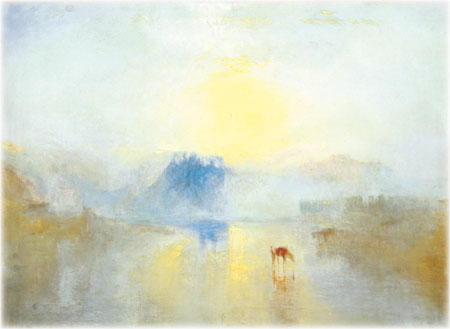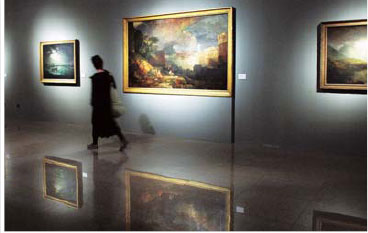|

|
|
Norham Castle, Sunrise circa 1845, a Turner masterpiece. [China Daily] |
It was during a trip to London that Fan Di'an was asked the dream question. "What exhibition would you like to stage in China more than any other?"
The question was put to the dean of the National Art Museum of China (NAMOC) by Martin Davidson, CEO of the British Council.
"Turner!" replied Fan without a moment's hesitation. To his delight, the deal was struck.
The long lines that formed for last weekend's opening were testament to the wisdom of his choice, as were the crowds that stuck closely to our gallery guide, hanging on her every word. Such is the enduring appeal of Joseph Mallord William Turner (1775-1851), one of Britain's best-known painters.
Fan is clearly delighted. "This exhibition offers a rare chance to look closely at an innovative artist who has exerted a great influence on Chinese oil and watercolor art since the early 20th century," he says.
Turner's name first came to China at a time when China was caught in the midst of social upheavals, partly because of encounters with Western powers. Under the banner of Revolution in the Fine Arts, Chinese artists then advocated a radical reform of traditional Chinese painting through the so-called Western Learning.
The introduction of European painting was thus regarded as a "new knowledge" crucial for the healthy growth of new Chinese art, according to Fan.
It was during this period that Chinese artists came to see Turner's importance in European art history and his significant contribution to the British school of painting.
In the 1920s, pioneering artists Xu Beihong (1895-1953) and Liu Haisu (1896-1994), both with a Western education background, called Turner "the representative of Naturalism"; in 1931, renowned art historian Feng Zikai (1898-1975) brought in Turner's works under the category of English Naturalism in The Art History of the West.
In the opinion of Chinese artists at that time, both French Realism and English Naturalism could help facilitate a revolution in the arts in China.
What impressed Chinese critics most was that Turner blurred the boundaries of the strict classifications, "imbuing his landscapes with closely observed atmospheric effects that created their own sense of historic drama", according to Fan.
Besides his oil art, Turner's watercolors also had a deep impact on Chinese artists.
In the 1930s, many Chinese artists, such as Li Jianchen and Pan Sitong, began to explore this art genre, drawing inspiration from Turner's works.
Again, in the 1950s, while socialist realism from Soviet Union played a key role in Chinese art, critics still managed to bring to China a selection of Western artists including Turner. At that time, the focus was his landscape and historical paintings.
A third wave of learning from Turner came in the early 1980s when China opened up to the world again after the end of the "cultural revolution" (1966-76).
"In this new era of open-mindedness and cultural renaissance, Turner, as well as other world masters, once again came into view with his nuances and complexities," notes art historian Ding Ning with Peking University.
In the following decade, Turner received a most extensive exposure in Chinese publishing, media and art academies.
"In my view, what intrigues us most about Turner is not his technique but his willingness to innovate and his attempt to capture the essence of the Industrial Revolution," points out Yang Feiyun, a renowned Chinese oil painter and dean of the Chinese Academy of Oil Painting.
However, Turner's long career polarized opinion, drawing both critical and material success, but also controversy and outrage.
"Few other British artists before, or since, have generated such wildly diverse responses to their work during their lifetimes or have continued to provoke such fervent debate," says Ian Warrell, curator of the first ever Turner exhibition in Asia.
Running through June 28 at the National Art Museum of China (NAMOC), the exhibition presents 112 oil paintings, sketches, and works on paper, all on loan from Tate Britain, the co-organizer of the show along with the British Council and NAMOC.
On display are Snow Storm: Hannibal and his Army Crossing the Alps 1812, one of Turner's finest achievements, The Decline of the Carthaginian Empire, and his most celebrated later canvases, such as Norham Castle, Sunrise circa 1845.
Turner is indisputably "one of the greatest painters in the history of Western art," notes Tate Britain director Stephen Deuchar.
Though Turner was acclaimed in his lifetime and, following his death in 1851, continued to have admirers and imitators internationally for much of the later 19th century, it was not until recently that the full extent of his artistic genius began to be understood, Deuchar says.
Daring to employ new techniques and new materials, Turner revolutionized British landscape painting and took it to new heights, say critics.
Turner is also seen by some as an early practitioner of impressionism and abstract art.
To help viewers better understand the displays, the exhibition will be equipped with videos on Turner's life and art.
Besides the electronic guides, 120 volunteers will be on hand in the display hall on the third floor of the art museum.
The coming months will also see Chinese scholars and art professors giving talks on Turner's art and classic Western art.
Two special "Turner Weeks" will run from May 1-7 and June 1-7, with free admission for university students and young children accompanied by their parents.
|

|
|
The show at the National Art Museum of China presents Turner's best known oil paintings, sketches and works on paper. [China Daily] |
(China Daily April 28, 2009)